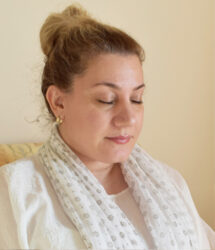New Year, Clean Slate

One glorious winter in the 1960s, a record-breaking snowstorm hovered over the Midwest for an entire week. To the delight of every child, school was closed as snow fell continuously for five days.
I remember the joy of waking up each morning to a fresh layer of snow. We’d bundle up, run outside and make a terrific mess with our fox-fox-goose trails, snow angels and forts. The brown oak leaves would cling to the snow as we rolled our giant snowballs, and by the end of the day our yard was a mess. But lo and behold, the next day the whole thing would be covered with soft pillowy drifts.
A fresh start.
Sometimes we all want a clean slate, a moment when we can erase the mistakes of the past and face a world as pristine as new fallen snow.
The New Year gives us a bit of a chance to do that. I imagine that is the allure of New Year’s Resolutions—we can convince ourselves that this year is going to be different. Somehow we’re going to stick to our diet, go to bed early and never, ever lose our temper again.
Of course, for most of us, that feeling lasts only a few days and then we forget all about our glorious intentions to start fresh.
Yet there is a way to start over, to renew ourselves on a daily basis, to really let go of our stresses and bad habits of the past and create the kind of life we want to be living.
We can do that by tapping into the infinite power of nature.
After all, we see Mother Nature creating new forms of life all around us every spring. Our bodies are renewing themselves afresh even as we speak, with our red blood cells replacing themselves every four months and our stomach cells every nine days.
We have that source of renewal inside us as well. Most of us sense that there is an inner source of wisdom, well-being and happiness that we can tap into at times. Maharishi Mahesh Yogi, the founder of the Transcendental Meditation technique, called it pure consciousness, the unchanging field that gives rise to all change (similar to the unified field of physics, an unchanging field that is the basis for all change in nature).
And fortunately for us, there is a natural technique for experiencing that field every day—a technique that has been handed down for generations in the Vedic tradition of knowledge and is called the Transcendental Meditation technique today.
The Ability to Change and Evolve is Within Us
When we meditate, we directly experience this field of pure consciousness, which could also be described as pure creativity, intelligence, energy and bliss. It’s not that we have to make a mood or repeat over and over, “I am happy. I am creative. I can make changes in my life.” It has nothing to do with thinking affirmations or creating resolutions. Rather, it has to do with going beyond thought to experience the changeless field within us that is by nature blissful, happy and evolutionary.
The Vedic literature describes the ultimate reality of life as sat chit ananda (sat = eternal, chit = consciousness and ananda = bliss). This means that the nature of chit, or pure consciousness, is ananda, is happiness.
So when we meditate and experience the state of samadhi, or transcendental consciousness, we don’t have to think “Now I’m going to be happy, now I’m going to be creative.” Like taking a bath, we are immersed in that state and don’t have to think, “I’m wet,” in order to feel clean.
So it’s not that you have to try to change, try to be more creative, try to be more happy. You already are that by nature.
Yet if this is true, you may ask, why don’t we experience this state of infinite happiness, creativity, and energy in every moment of our lives?
The answer is stress.
Removing the Obstacles to the Flow of Consciousness
Stress and fatigue cloud our minds, disrupt physical health and prevent us from experiencing our own life force—the pure joy, happiness, and energy for renewal and positive change within us.
You could think of your life force as water flowing down a river. The river flows eternally, a source of power and joy and energy. But if twigs, logs, and other debris block its flow, you may only experience a trickle of its true power. If you remove the blockage, you can experience the unbounded force of the river again.
There is actually a verse in the Yoga Sutra, the classic textbook of yoga and meditation from the Vedic tradition, that says exactly this. In Sanskrit it says, nimmitam aprayajakam prakrtinam varana-bhedas tu tatah ksetrikavat, which translates as: “The apparent cause of natural change is not the real cause, but rather the removal of an obstacle. In this it is like the farmer who channels water for crops by removing barriers.”
Of course, the Yoga Sutra is not talking about farming—this is an analogy for the mechanics of meditation. This verse is reminding us that we don’t create pure consciousness, our life force, which is the source of all positive change in our lives. That is already inside us. That’s our natural state, one of creativity and flow and happiness. As we have seen, our own essential nature is sat chit ananda, absolute bliss consciousness.
Like the farmer, we only need to remove the obstacles to enjoy its benefits. And for us, the obstacles are stresses and strains in the mind and body. Once they are removed, the nervous system starts to enjoy its natural state, and the natural state of life is one of infinite happiness and creativity and constant renewal.
The TM technique provides such a deep state of rest that stresses and strains are dissolved. Because it provides such deep rest, it’s especially effective in removing the deeper kinds of stresses that a good night’s sleep can’t touch. That’s why, after practicing TM, many women report, “I feel rejuvenated, renewed.” Or, “I feel like I have a fresh start in life.” Or, “I get more done each day.”
It’s about getting rid of the clutter and pressure and finding a fresh field inside yourself, from which you can create the life you want to create.
As Heather Hancock, CEO, said after learning TM, “There was no clutter in my mind anymore, and I started to do things at work in a lot less time; something that used to take three hours now takes one.”
Megan Fairchild, the NYC Ballet star who recently took a year off to headline the Broadway musical On the Town, says, “TM helps in everything. It helps my patience level, I’m more organized and more productive, and I sleep better.”
And Rosalie van den Bos, a graduate of Maharishi University of Management writes, “We are the designers of our lives, and our own routines. I’ve learned that it is really our own choice to feel happy, or sad. And by transcending every day, we are designing a better life and a better world.”
So for this New Year, give yourself a fresh start, a gift of transcendence, of the flow of all life’s bounty and goodness. Start practicing the Transcendental Meditation technique, and begin to experience the fullness of life as you always dreamed it could be lived.
About the Author
Linda Egenes writes about green and healthy living and is the author of six books, including The Ramayana: A New Retelling of Valmiki’s Ancient Epic—Complete and Comprehensive, co-authored with Kumuda Reddy, M.D.
More Posts by Linda
- Tired and Burned Out? Transcendental Meditation Can Help: An Interview with Dr. Nancy Lonsdorf, MD
- Worried About the Future? Six Ways to Calm Your Anxiety
- What Do You Carry in Your Self-Care Tool Kit?
- Five Strategies for Family Caregivers
- From the Streets to College in Four Months: The Communiversity of South Africa Empowers Underserved Youth in Cape Town





